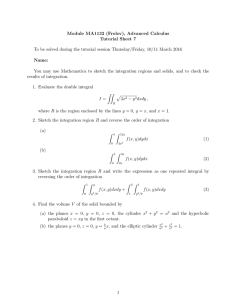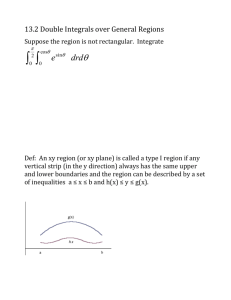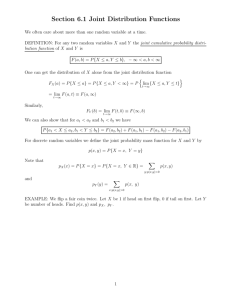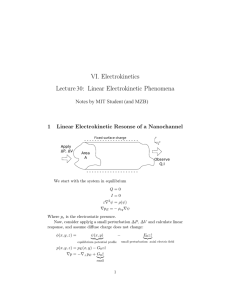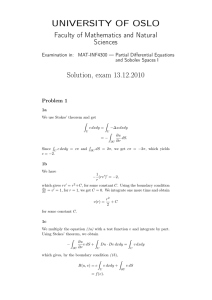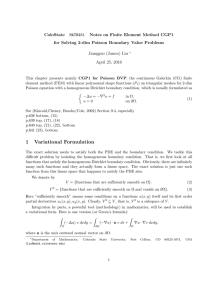Data-driven optimal transport
advertisement
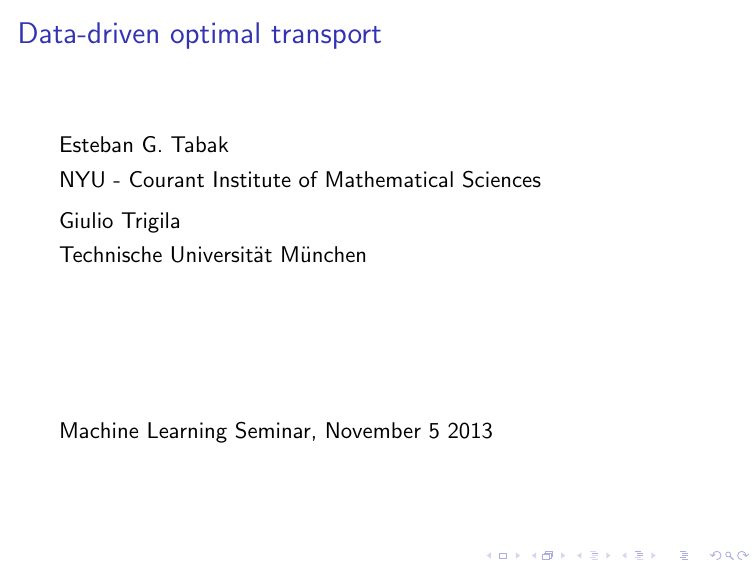
Data-driven optimal transport
Esteban G. Tabak
NYU - Courant Institute of Mathematical Sciences
Giulio Trigila
Technische Universität München
Machine Learning Seminar, November 5 2013
The story in a picture
µ (y)
ρ (x)
Y
X
π (x,y)
xi
yj
Optimal transport (Monge formulation)
Find a plan to transport material from one location to another that
minimizes the total transportation cost. In terms of the probability
densities ρ(x) and µ(y ) with x, y ∈ Rn ,
Z
min M(y ) =
c(x, y (x)) ρ(x)dx.
y (x)
Rn
subject to
Z
Z
ρ(x)dx =
y −1 (Ω)
µ(y )dy
Ω
for all measurable sets Ω. If y is smooth and one to one, this is
equivalent to the point-wise relation
ρ(x) = µ(y (x))J y (x),
Kantorovich formulation
Z
min K (π) =
c(x, y ) π(x, y )dxdy
π(x,y )
subject to
Z
ρ(x) =
Z
π(x, y )dy ,
µ(y ) =
π(x, y )dx
If c(x, y ) is convex,
min M(y ) = max K (π)
and
π(S) = ρ({x : (x, y (x)) ∈ S}).
Dual formulation
Maximize
Z
D(u, v ) =
Z
u(x)ρ(x)dx +
v (x)µ(y )dy
over all continuous functions u and v satisfying
u(x) + v (y ) ≤ c(x, y ).
The standard example: c(c, y ) = ky − xk2
Z
min
Z
c(x, y ) π(x, y )dxdy → max
with dual
Z
Z
min u(x)ρ(x)dx + v (y )µ(y )dy ,
x · y π(x, y )dxdy ,
u(x) + v (y ) ≥ x · y .
u(x) = max(x · y − v (y )) ≡ v ∗ (x)
y
v (y ) = max(x · y − u(x)) ≡ u ∗ (y )
x
and the optimal map for Monge’s problem is given by
y (x) = ∇u(x),
with potential u(x) satisfying the Monge-Ampere equation
ρ(x) = µ(∇u(x))det(D 2 u)(x).
A data-based formulation
In Kantorovich dual formulation, the objective function to
maximize is a sum of two expected values:
Z
Z
D(u, v ) = u(x)ρ(x)dx + v (x)µ(y )dy .
Hence, if ρ(x) and µ(y ) are known only through samples, it is
natural to pose the problem in terms of empirical means:
Maximize
m
n
i=1
j=1
1X
1 X
u(xi ) +
v (yj )
D(u, v ) =
m
n
over functions u and v satisfying
u(x) + v (y ) ≤ c(x, y ).
A purely discrete reduction
Maximize
m
D(u, v ) =
n
1 X
1X
ui +
vj
m
n
i=1
(1)
j=1
over vectors u and v satisfying
ui + vj ≤ cij .
(2)
This is dual to the uncapacitated transportation problem:
Minimize
C (π) =
X
cij πij
(3)
i,j
subject to
X
πij
= n
(4)
πij
= m.
(5)
j
X
i
Fully constrained scenario
m
n
i=1
j=1
1 X
1X
D(u, v ) =
u(xi )+
v (yj ) =
m
n
Z
Z
u(x)ρ(x)dx+ v (x)µ(y )dy
with
ρ(x) =
m
n
i=1
j=1
1 X
1X
δ(x − xi ), µ(y ) =
δ(y − yj ),
m
n
which brings us back to the purely discrete case.
The Lagrangian
Z
L(π, u, v ) =
c(x, y ) π(x, y ) dxdy
#
Z "
m
1 X
δ(x − xi ) u(x)dx
−
ρ(x) −
m
i=1
Z
n
X
1
− µ(y ) −
δ(y − yj ) v (y )dy ,
n
j=1
where ρ(x) and µ(y ) are shortcut notations for
Z
ρ(x) = π(x, y )dy
and
Z
µ(y ) =
π(x, y )dx.
In terms of the Lagrangian, the problem can be formulated as a
game:
d : max
min L(π, u, v ),
u(x),v (y ) π(x,y )≥0
with dual
p:
min
max L(π, u, v ).
π(x,y )≥0 u(x),v (y )
If the functions u(x) and v (y ) are unrestricted, the problem p
becomes
Z
p : min
c(x, y ) π(x, y ) dxdy
π(x,y )≥0
subject to
ρ(x) =
as before.
m
n
i=1
j=1
1X
1 X
δ(x − xi ), µ(y ) =
δ(y − yj ),
m
n
A suitable relaxation
Instead, restrictict the space of functions F from where u and v
can be selected. If F is invariant under dilations:
u ∈ F , λ ∈ R → λu ∈ F ,
then the problem p becomes
Z
c(x, y ) π(x, y ) dxdy
p : min
π(x,y )≥0
#
m
1 X
ρ(x) −
δ(x − xi ) u(x)dx
m
i=1
Z
n
X
µ(y ) − 1
δ(y − yj ) v (y )dy
n
Z "
= 0,
= 0
j=1
for all u(x), v (y ) ∈ F , a weak formulation of the constraints.
Some possible choices for F
1. Constants: The constraints just guaranty that ρ and µ
integrate to one.
2. Linear Functions: The solution is a rigid displacement that
moves the mean of {xi } into the mean of {yj }.
3. Quadratic Functions: A linear transformation mapping the
empirical mean and covariance matrix of {xi } into those of
{yj }.
4. Smooth functions with appropriate local bandwidth,
neither to over nor under-resolve ρ(x) and µ(y ).
A flow-based, primal-dual approach
1
c = kx − y k2 , y (x) = ∇u(x).
2
We think of the map y (x) as the endpoint of a time-dependent
flow z(x, t), such that
z(x, 0) = x,
and z(x, ∞) = y (x).
z(x, t) follows the gradient flow
"
#
δ
D̃
t
ż = −∇z
δu
u= 12 kxk2
z(x, 0) = x
where
Z
D̃t =
Z
u(z)ρt (z)dz +
u ∗ (y )µ(y )dy
and ρt is the evolving probability distribution underlying the points
z(x, t).
The variational derivative of D̃ adopts the form
δ D̃t
= ρt − D 2 u µ(∇u)
δu
which, applied at u = 12 kxk2 (the potential corresponding to the
identity map), yields the simpler expression
δ D̃t
(z) = ρt (z) − µ(z),
δu
so
(
ż = −∇z [ρt (z) − µ(z)]
z(x, 0) = x
The probability density ρt satisfies the continuity equation
∂ρt (z)
+ ∇z · [ρt (z)ż] = 0,
∂t
yielding
∂ρt (z)
− ∇z · [ρt (z)∇z (ρt (z) − µ(z))] = 0,
∂t
a nonlinear heat equation that converges to ρt=∞ (z) = µ(z).
In terms of samples,
1. Objetive function:
Z
Z
1 X
1X ∗
D̃t = u(z)ρt (z)dz+ u ∗ (y )µ(y )dy →
u(zi )+
u (yj )
m
n
i
j
2. Test functions: General u(z) ∈ F → localized u(z, β), with
β a finite-dimensional parameter and appropriate bandwidth.
3. Gradient descent: −u̇ =
−β̇ = ∇β D̃t (z) =
δ D̃t
δu (z)
= ρt (z) − µ(z) →
1 X
1X
∇β u(zi ) −
∇β u(yj )
m
n
i
j
Left to discuss:
1. Form of u(z, β), determination of bandwidth:
X
kz − zk k
1
2
βk Fk
,
u(z, β) = kxk +
2
αk
k
αk ∝
1
ρt (zk )
1
2. Enforcement of the map’s optimality.
d
.
Some applications and extensions
1. Maps: fluid flow from tracers, effects of a medical treatment,
resource allocation, . . .
2. Density estimation: ρ(x)
3. Classification and clustering: ρk (x)
4. Regression: π(x, y ), dim(x) 6= dim(y ),
c(x, y ) =
X
k
wk
ky − yk k2
αk2 + kx − xk k2
5. Determination of worst scenario under given marginals:
π(x1 , x2 , . . . , xn )
Thanks!

